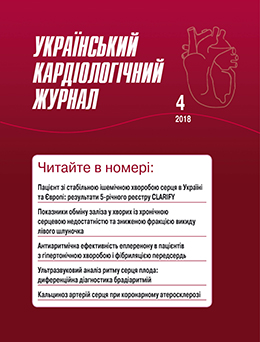New clinical-echocardiographic method to reveal obstructive сoronary artery disease presence with index of coronary obstruction calculation: its characteristics and verification
Main Article Content
Abstract
The aim – to elaborate and to validate the combined non-invasive method to reveal the obstructive сoronary artery disease (CAD) presence using its clinical pretest probability value in conjunction with tissue Doppler data of local systolic wall motion.
Material and methods. 81 pts with typical anginal and atypical chest pain and known absence of structural myocardial diseases as well as history of myocardial infarction and coronary revascularization, 64 % men, age 56.2±9.9 yrs old were examined. All patients were divided into investigational (teaching) and checking group (49 and 32 patients, accordingly) comparable by age, gender and main comorbidities rates. The index of coronary obstruction (INCO) was expressed in conventional units and was calculated as the ratio of CAD pretest probability to mean systolic wall motion velocity of 12 myocardial segments by tissue Doppler imaging.
Results. Invasive angiography identified obstructive lesions of coronary arteries in 37 patients, including 23 patients (47 %) of the investigational group and 14 (44 %) in checking group. The investigational group patients’ INCO composed 7.8±3.8 conv units with bimodal distribution of the parameter and cut-off point at 8 conv units which corresponds to 80 % sensitivity and 91 % specificity, AUC in ROC analysis 0,965. Comparable diagnostic properties of INCO at 8 conv units were confirmed during the further analysis in checking group with 85 % sensitivity and 95 % specificity, AUC 0.971.
Conclusions. New complex non-invasive diagnostic method including INCO calculation based on CAD pretest probability and local systolic wall motion velocities evaluation by tissue Doppler was proposed. High INCO sensitivity and specificity at value – 8 conv units to determine obstructive lesions in coronary arteries were shown. INCO calculation may be widely used at the first step of non-invasive diagnosis in suspected CAD, as well as for determination of the further strategy in patients after coronary revascularization.
Article Details
Keywords:
References
Kovalenko V.M. Recommendations of the working group on functional diagnostics of the Association of Cardiologists of Ukraine and the Ukrainian Association of Echocardiography Specialists. Kyiv, 2009.
Order of МОЗ №152 from 02.03.16 About a statement andintroduction of medical and technological documents ofstandardization of medicare at stable ischemic heart trouble http://old.moz.gov.ua/ua/portal/.
Berry C. Stable Coronary Syndromes: The Case for Consolidating the Nomenclature of Stable Ishemic Heart Disease. Circulation. 2017;136:437–439.
Bittencourt MS, Hulten E, Polonsky TS, Hoffman U, Nasir K, Abbara. Еuropean Society of Cardiology-Recommended Coronary Artery Disease Consortium Pretest Probability Scores More Accurately Predict Obstructive Coronary Disease and Cardiovascular Events Than the Diamond and Forrester Score: The Partners Registry. Circulation AHA. 2016;159:509.
Ibanez B, James S, Agewall S, Antunes MJ, Bucciarelli-Ducci C, Bueno H, Caforio ALP, Crea F, Goudevenos JA, Halvorsen S, Hindricks G, Kastrati A, Lenzen MJ, Prescott E, Roffi M, Valgimigli M, Varenhorst C, Vranckx P, Widimský P; ESC Scientific Document Group. ESC Guidelines for the management of acute myocardial infarction in patients presenting with ST-segment elevation. Eur Heart J. 2018 Jan 7;39(2):119–177. doi: 10.1093/eurheartj/ehx393.
Froelicher VF, Lehmann KG, Thomas R, Goldman S, Morrison D, Edson R, Lavori P, Myers J, Dennis C, Shabetai R, Do D, Froning J. The electrocardiographic еxercise test in a population with reduced workup bias: diagnostic performance, computerized interpretation, and multivariable prediction. Veterans Affairs Cooperative Study in Health Services 016 (QUEXTA) Study Group. Quantitative Exercise Testing and Angiography. Ann Intern Med. 1998;128:965–974.
Кaski J. Provocative tests for coronary artery spasm in MINOCA: necessary and safe? European Heart Journal. 2018;39:99–101.
Morise AP, Diamond GA. Comparison of the sensitivity and specificity of exercise electrocardiography in biased and unbiased populations of men and women. Am Heart . 1995;130:741–747.
Stable Coronary Artery Disease. Management of ESC Clinical Practice Guidelines Reference. Eur Heart J. 2013;34:2949–3003.
Utility of the Diamond-Forrester Classification in Stratifying Acute Chest Pain in an Academic Chest Pain Center. Circulatiоn. 2016;15:56–9.

